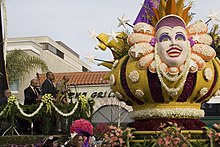Crop art

Crop artis an environmental art practice using plants and seeds in the landscape to create statements, marks and/or images.Agnes Denes,Matthew Moore (artist),Dennis OppenheimandStan Herdare practitioners of Crop art.[1][2][3][4]Some works ofLand art,andEarth artare similar in scale, and can be seen only from aerial viewpoints.
Historical precedents
[edit]

Onefolk artversion of crop art is calledseed art,avisual artform created inmosaic-style, similar to the technique ofpointillismin painting, orneedlepointtextiles. Seed mosaic images are created by fixingvegetable matter,especiallyseeds,to a background. Coleen Sheehy,[5]inSeed Queenquotes a classic text on the subject:Decorating with Seed mosaics, Chipped Glass and Plant materials(first pub.1960) by Elenor Van Rennslaer[6]"...mosaics are tiles, glass, or stones set in mortar. Instead of these you can create a different kind of mosaic using such plant materials as seeds, tiny pods, and flowers" (Sheehy 49). An example is theCorn Palaceof Mitchell, South Dakota, that was first built for the 1892 Corn Exposition. Outer walls of the building were -and still are- covered in murals made from multi-colored ears of corn (Sheehy 24) The seed mosaic portraits byLillian Coltonare also examples. Her seed portraits of celebrities were exhibited in the strictly defined "Crop art" category at theMinnesota State Fairbeginning in 1966. Rules for entry of Crop art allow "only seeds from Minnesota-grown farm crops or cultivated garden flowers, fruits, and vegetables" with no wild plant seeds permitted. Colton continued to teach and make Crop art until her death at age 95 in 2007 (Sheehy 2). A new generation of Crop, or Seed artists, known as the "Postmodern School of Minnesota Crop Art" (Sheehy 90) is continuing this folk tradition. Some of these artists are "Cathy Camper, Alan Carpenter, Kim Cope, Linda Koutsky, Nancy Loung, Suzy Mears, Laura Melnick, and David Steinlicht" (Sheehy 90). There is a custodial aspect and preservation ethic associated with this plant-based art form.[citation needed]Making Crop art is not only a way preserving and rejuvenating a vibrant folk craft but its practice foregrounds the need to collect, store, and value the lore and varieties of seeds.[citation needed] In Los Angeles, theTournament of Roses Paradefloats employ the flowers of plants in a similar collage or mosaic style.
Crop circles
[edit]The term Crop art might be used to describe formations known ascrop circles.[7]Crop Circles first came to mass media attention during the 1980s after they were noticed in some agricultural fields in southern England (Ency Rel/Spir). Most often the images consist of very large and intricate series of rings and lines formed when standing crops, such as wheat and rye are flattened into patterns. Some attribute these designs to the marks left by landings of extra terrestrial craft because the images are usually very large, appear over a short period of time, and some do not show any visible tracks into or out of the design. These same type of figures are found all over the world; though many do not attribute their manifestation to visitations by alien beings. Crop Circles are sometimes called crop formations, agroglyphs, orpictograms.Some are also created by recognized "landscape artists" for commercial purposes.[7]
See also
[edit]References and footnotes
[edit]- ^Pollack, Maika."Interview: Agnes Denes".Interview Magazine.Retrieved15 August2017.
- ^Vanesian, Kathleen (January 13, 2010)."Food for Thought: Artist Matthew Moore to Show Work at 2010 Sundance Film Festival".Phoenix New Times.Retrieved15 August2017.
- ^"Dennis Oppenheim: Directed Seeding - Cancelled Crop 1969".Tate Museum.Retrieved15 August2017.
- ^Crop Art and Other Earthworks.Stan Herd. New York: Harry N. Abrams, Inc., 1994
- ^Seed Queenby Coleen Sheehy, Minnesota Historical Society Press: St. Paul, MN, 2007
- ^Eleanor Van RennslaerDecorating with Seed mosaics, Chipped Glass and Plant materialsKessinger Publishing, LLC (July 23, 2009)
- ^ab"Crop Circles." Encyclopedia of Religious and Spiritual Development. 2005. SAGE Publications. 20 Nov. 2009. <http://www.sage-ereference.com/religion/Article_n57.htmlArchived2012-09-09 atarchive.today>. Eltjo H. Haselhoff
